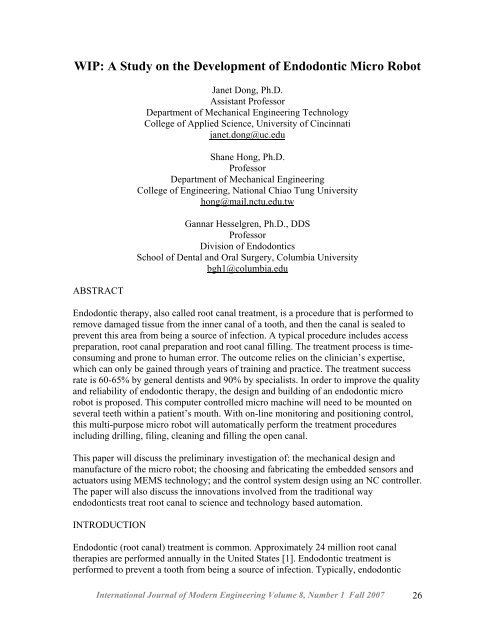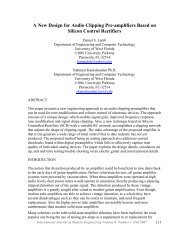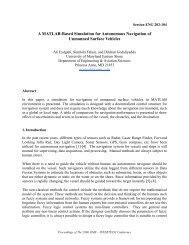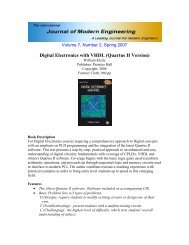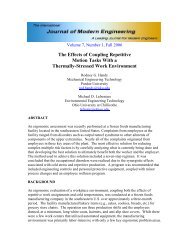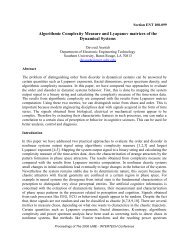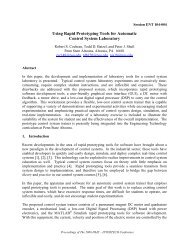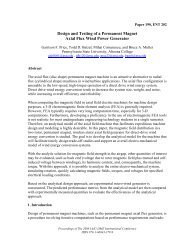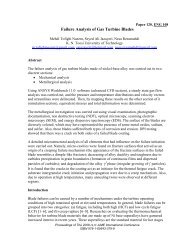WIP: A Study on the Development of Endodontic Micro Robot - IJME
WIP: A Study on the Development of Endodontic Micro Robot - IJME
WIP: A Study on the Development of Endodontic Micro Robot - IJME
You also want an ePaper? Increase the reach of your titles
YUMPU automatically turns print PDFs into web optimized ePapers that Google loves.
<str<strong>on</strong>g>WIP</str<strong>on</strong>g>: A <str<strong>on</strong>g>Study</str<strong>on</strong>g> <strong>on</strong> <strong>the</strong> <strong>Development</strong> <strong>of</strong> Endod<strong>on</strong>tic <strong>Micro</strong> <strong>Robot</strong><br />
ABSTRACT<br />
Janet D<strong>on</strong>g, Ph.D.<br />
Assistant Pr<strong>of</strong>essor<br />
Department <strong>of</strong> Mechanical Engineering Technology<br />
College <strong>of</strong> Applied Science, University <strong>of</strong> Cincinnati<br />
janet.d<strong>on</strong>g@uc.edu<br />
Shane H<strong>on</strong>g, Ph.D.<br />
Pr<strong>of</strong>essor<br />
Department <strong>of</strong> Mechanical Engineering<br />
College <strong>of</strong> Engineering, Nati<strong>on</strong>al Chiao Tung University<br />
h<strong>on</strong>g@mail.nctu.edu.tw<br />
Gannar Hesselgren, Ph.D., DDS<br />
Pr<strong>of</strong>essor<br />
Divisi<strong>on</strong> <strong>of</strong> Endod<strong>on</strong>tics<br />
School <strong>of</strong> Dental and Oral Surgery, Columbia University<br />
bgh1@columbia.edu<br />
Endod<strong>on</strong>tic <strong>the</strong>rapy, also called root canal treatment, is a procedure that is performed to<br />
remove damaged tissue from <strong>the</strong> inner canal <strong>of</strong> a tooth, and <strong>the</strong>n <strong>the</strong> canal is sealed to<br />
prevent this area from being a source <strong>of</strong> infecti<strong>on</strong>. A typical procedure includes access<br />
preparati<strong>on</strong>, root canal preparati<strong>on</strong> and root canal filling. The treatment process is timec<strong>on</strong>suming<br />
and pr<strong>on</strong>e to human error. The outcome relies <strong>on</strong> <strong>the</strong> clinician’s expertise,<br />
which can <strong>on</strong>ly be gained through years <strong>of</strong> training and practice. The treatment success<br />
rate is 60-65% by general dentists and 90% by specialists. In order to improve <strong>the</strong> quality<br />
and reliability <strong>of</strong> endod<strong>on</strong>tic <strong>the</strong>rapy, <strong>the</strong> design and building <strong>of</strong> an endod<strong>on</strong>tic micro<br />
robot is proposed. This computer c<strong>on</strong>trolled micro machine will need to be mounted <strong>on</strong><br />
several teeth within a patient’s mouth. With <strong>on</strong>-line m<strong>on</strong>itoring and positi<strong>on</strong>ing c<strong>on</strong>trol,<br />
this multi-purpose micro robot will automatically perform <strong>the</strong> treatment procedures<br />
including drilling, filing, cleaning and filling <strong>the</strong> open canal.<br />
This paper will discuss <strong>the</strong> preliminary investigati<strong>on</strong> <strong>of</strong>: <strong>the</strong> mechanical design and<br />
manufacture <strong>of</strong> <strong>the</strong> micro robot; <strong>the</strong> choosing and fabricating <strong>the</strong> embedded sensors and<br />
actuators using MEMS technology; and <strong>the</strong> c<strong>on</strong>trol system design using an NC c<strong>on</strong>troller.<br />
The paper will also discuss <strong>the</strong> innovati<strong>on</strong>s involved from <strong>the</strong> traditi<strong>on</strong>al way<br />
endod<strong>on</strong>ticsts treat root canal to science and technology based automati<strong>on</strong>.<br />
INTRODUCTION<br />
Endod<strong>on</strong>tic (root canal) treatment is comm<strong>on</strong>. Approximately 24 milli<strong>on</strong> root canal<br />
<strong>the</strong>rapies are performed annually in <strong>the</strong> United States [1]. Endod<strong>on</strong>tic treatment is<br />
performed to prevent a tooth from being a source <strong>of</strong> infecti<strong>on</strong>. Typically, endod<strong>on</strong>tic<br />
Internati<strong>on</strong>al Journal <strong>of</strong> Modern Engineering Volume 8, Number 1 Fall 2007 26
treatment involves root canal preparati<strong>on</strong> and root filling. The root canal preparati<strong>on</strong>,<br />
better known as preparing <strong>the</strong> root canal for root filling, can be divided into three phases:<br />
(1) access preparati<strong>on</strong>, (2) cor<strong>on</strong>al canal preparati<strong>on</strong>, and (3) apical canal preparati<strong>on</strong>.<br />
Figure 1 shows canal characteristics and <strong>the</strong> three phases in canal preparati<strong>on</strong> for a<br />
posterior tooth.<br />
Zero reference plane<br />
Crown<br />
Chamber<br />
Canal orifice<br />
Cor<strong>on</strong>al access preparati<strong>on</strong><br />
Straight-line access stop point<br />
Root<br />
Root canal<br />
Straight-line access preparati<strong>on</strong><br />
or<br />
cor<strong>on</strong>al canal preparati<strong>on</strong><br />
Apical canal preparati<strong>on</strong><br />
Apical c<strong>on</strong>stricti<strong>on</strong><br />
Figure 1. Canal Characteristics and Three Phases in Root Canal Treatment Preparati<strong>on</strong><br />
The endod<strong>on</strong>tic access preparati<strong>on</strong> is to create an unimpeded passageway to <strong>the</strong> pulpal<br />
space and <strong>the</strong> apical porti<strong>on</strong> <strong>of</strong> <strong>the</strong> root canal [2]. By using an access bur attached to a<br />
high-speed turbine hand-piece, <strong>the</strong> chamber is unro<strong>of</strong>ed, and canal orifices are exposed.<br />
In order to obtain instrument c<strong>on</strong>trol, <strong>the</strong> straight-line access to <strong>the</strong> apical porti<strong>on</strong> <strong>of</strong> <strong>the</strong><br />
root canal is created during access and cor<strong>on</strong>al canal preparati<strong>on</strong> [3]. Cor<strong>on</strong>al and apical<br />
canal preparati<strong>on</strong> is also called root canal cleaning and shaping. Successful cleaning<br />
entails <strong>the</strong> use <strong>of</strong> various instruments, <strong>the</strong> first will physically loosen and remove s<strong>of</strong>t and<br />
hard tissue; <strong>the</strong> sec<strong>on</strong>d is an irrigating system to flush loosened materials away, and <strong>the</strong><br />
third will inject chemicals to dissolve <strong>the</strong> infecti<strong>on</strong> from <strong>the</strong> inaccessible regi<strong>on</strong>s. Root<br />
canal shaping is a mechanical process accomplished with a variety <strong>of</strong> instruments. This<br />
process is to establish a c<strong>on</strong>tinuously shaped c<strong>on</strong>ical form from apical to cor<strong>on</strong>al to<br />
facilitate <strong>the</strong> filling <strong>of</strong> <strong>the</strong> root canals with gutta-percha c<strong>on</strong>es and sealer that are today’s<br />
most comm<strong>on</strong>ly used filling materials [4].<br />
The successful outcome <strong>of</strong> <strong>the</strong> preparati<strong>on</strong> depends largely <strong>on</strong> <strong>the</strong> clinician's expertise,<br />
including his/her tactile sense and judgment. To expose <strong>the</strong> canal orifices and establish a<br />
straight-line access to <strong>the</strong> canal, a relatively large amount <strong>of</strong> <strong>the</strong> tooth structure must be<br />
removed during access preparati<strong>on</strong>. This removal can be excessive and may weaken <strong>the</strong><br />
tooth.<br />
There are additi<strong>on</strong>al problems that can occur in <strong>the</strong> current endod<strong>on</strong>tic techniques for<br />
canal preparati<strong>on</strong> [5] [6]. The following are examples:<br />
Internati<strong>on</strong>al Journal <strong>of</strong> Modern Engineering Volume 8, Number 1 Fall 2007 27
• Perforati<strong>on</strong> and Furcal Perforati<strong>on</strong>-This causes period<strong>on</strong>tal (surrounding tissues)<br />
destructi<strong>on</strong>, weakens tooth structure, and <strong>of</strong>ten-subsequent loss <strong>of</strong> <strong>the</strong> tooth;<br />
• Canal Ledging-This is an artificially created irregularity in <strong>the</strong> surface <strong>of</strong> <strong>the</strong> root<br />
canal wall that prevents <strong>the</strong> placement <strong>of</strong> instruments <strong>of</strong> proper length into <strong>the</strong><br />
original canal path,<br />
• Transportati<strong>on</strong> <strong>of</strong> <strong>the</strong> Apical Porti<strong>on</strong> <strong>of</strong> <strong>the</strong> Canal-Characterized by a normal<br />
curved canal that has been straightened, especially in <strong>the</strong> apical third;<br />
• Stripping, or Lateral Wall Perforati<strong>on</strong>-Primarily caused by overzealous<br />
instrumentati<strong>on</strong> in <strong>the</strong> mid-root area<br />
• Excessive Instrumentati<strong>on</strong> Bey<strong>on</strong>d <strong>the</strong> Apical C<strong>on</strong>structi<strong>on</strong>-causing damage to <strong>the</strong><br />
period<strong>on</strong>tal ligament and alveolar b<strong>on</strong>e<br />
• Inadequate Canal Preparati<strong>on</strong>-This is <strong>the</strong> failure to remove pulp tissue, dentinal<br />
debris, and microorganisms from <strong>the</strong> root canal system;<br />
• Improperly Shaped Root Canal-Which prevents adequate filling.<br />
The problems identified above cannot be resolved solely by training. Endod<strong>on</strong>tics is a<br />
clinical specialty, but <strong>the</strong> great need for endod<strong>on</strong>tic <strong>the</strong>rapy makes it impossible for <strong>the</strong>se<br />
specialists to handle all cases. These problems have created a need for advanced<br />
endod<strong>on</strong>tic technology innovati<strong>on</strong> by applying advanced engineering and computer aided<br />
technology to reduce <strong>the</strong> potential for human error and improve <strong>the</strong> quality <strong>of</strong> care during<br />
endod<strong>on</strong>tic <strong>the</strong>rapy.<br />
The need for advanced endod<strong>on</strong>tic technology prompted <strong>the</strong> research <strong>of</strong> “Advanced<br />
Endod<strong>on</strong>tic Technology <strong>Development</strong>”. The Advanced Endod<strong>on</strong>tic Technology<br />
<strong>Development</strong> project c<strong>on</strong>sists <strong>of</strong> four sub-subjects:<br />
(1) <strong>Development</strong> <strong>of</strong> a technique to thoroughly assess <strong>the</strong> tooth’s c<strong>on</strong>diti<strong>on</strong> using 2-<br />
dimensi<strong>on</strong>al x-ray images to build a computer 3-D tooth model, displaying state-<strong>of</strong><strong>the</strong>-art<br />
computer graphics;<br />
(2) Develop an automatic prescripti<strong>on</strong> system from <strong>the</strong> 3-D root canal model, using<br />
computer-aided treatment procedure planning;<br />
(3) Design and build a smart multi-purpose precisi<strong>on</strong> micro machine to perform<br />
automated root canal treatment;<br />
(4) Develop a new ultras<strong>on</strong>ic cleaning tool with pressure assisted jetting/vacuum waste<br />
removal.<br />
The development <strong>of</strong> an endod<strong>on</strong>tic micro machine is <strong>the</strong> center piece <strong>of</strong> <strong>the</strong> Advanced<br />
Endod<strong>on</strong>tic Technology <strong>Development</strong> project. The final implementati<strong>on</strong> <strong>of</strong> this advanced<br />
endod<strong>on</strong>tic technology will result in a micro machine with a precisi<strong>on</strong> bey<strong>on</strong>d what <strong>the</strong><br />
human hand can achieve. This computer-c<strong>on</strong>trolled machine will be mounted <strong>on</strong> several<br />
teeth within <strong>the</strong> patient’s mouth. With <strong>on</strong>-line m<strong>on</strong>itoring and intelligent c<strong>on</strong>trol, <strong>the</strong><br />
micro machine or robot will perform <strong>the</strong> automated drilling, cleaning, and filling <strong>of</strong> <strong>the</strong><br />
root canal. All o<strong>the</strong>r sub-project results will be incorporated into this robotic operati<strong>on</strong>.<br />
Internati<strong>on</strong>al Journal <strong>of</strong> Modern Engineering Volume 8, Number 1 Fall 2007 28
This paper will focus <strong>on</strong> <strong>the</strong> preliminary study <strong>of</strong> <strong>the</strong> mechanical design <strong>of</strong> an endod<strong>on</strong>tic<br />
robot, <strong>the</strong> choosing and fabricati<strong>on</strong> <strong>of</strong> embedded sensors, and <strong>the</strong> design <strong>of</strong> <strong>the</strong> c<strong>on</strong>trol<br />
system with an NC c<strong>on</strong>troller for robotic moti<strong>on</strong>.<br />
ESSENCES IN ENDODONTIC PROCESS AUTOMATION<br />
Root canal shaping is a mechanical process that is currently d<strong>on</strong>e with hand files and<br />
reamers, al<strong>on</strong>g with drills <strong>of</strong> various designs and tools that attach to rotary engines <strong>of</strong><br />
different speeds. In principle, though not in scale, it does not differ from <strong>the</strong><br />
drilling/reaming process in <strong>the</strong> machining industry. The machining industry has moved<br />
from manual operati<strong>on</strong> to Numerical C<strong>on</strong>trol (NC) and Computer Numerical C<strong>on</strong>trol<br />
(CNC). The quality and accuracy <strong>of</strong> a produced part is c<strong>on</strong>trolled by a computer program<br />
<strong>on</strong> an automatic precisi<strong>on</strong> machine. This master skill, so critical in <strong>the</strong> past, is no l<strong>on</strong>ger<br />
needed. Currently in endod<strong>on</strong>tics, <strong>the</strong> success <strong>of</strong> <strong>the</strong> root canal shaping principally<br />
depends <strong>on</strong> <strong>the</strong> skill and thoroughness <strong>of</strong> <strong>the</strong> clinician. This is because endod<strong>on</strong>tic<br />
<strong>the</strong>rapy relies almost entirely <strong>on</strong> “feel” - <strong>the</strong> tactile sense <strong>of</strong> <strong>the</strong> clinicians [7]. The quality<br />
and accuracy <strong>of</strong> clinical care could be greatly enhanced by applying available<br />
technological advancements, such as process automati<strong>on</strong> with NC c<strong>on</strong>trolled micro robot,<br />
to this <strong>the</strong>rapy.<br />
The tasks to develop this micro robot include:<br />
(1) Defining <strong>the</strong> specificati<strong>on</strong>s and requirements for this robot;<br />
(2) Mechanical design, manufacture, and mounting <strong>of</strong> <strong>the</strong> robot;<br />
(3) Design, select or fabricati<strong>on</strong> <strong>the</strong> sensors and actuators;<br />
(4) Design and development <strong>of</strong> <strong>the</strong> c<strong>on</strong>trol system.<br />
ENDODONTIC MICRO ROBOT SPECIFICATIONS AND REQUIREMENTS<br />
Specific objectives for micro robot design include: (1) reducing <strong>the</strong> reliance <strong>on</strong> <strong>the</strong> skills<br />
<strong>of</strong> <strong>the</strong> dentist, (2) minimizing human error, and (3) <strong>of</strong>fering a method for precise<br />
diagnosis and treatment.<br />
In order to determine <strong>the</strong> engineering features for <strong>the</strong> micro robot, a survey was<br />
developed and sent to dentists and endod<strong>on</strong>tists in <strong>the</strong> greater Cincinnati area [8]. The<br />
survey results indicate that <strong>the</strong> machine should have <strong>the</strong> following features:<br />
• A micro-positi<strong>on</strong> and orientati<strong>on</strong> adjustment to ensure that <strong>the</strong> tools start at a<br />
precise point;<br />
• An automatic feed rate and travel distance c<strong>on</strong>trol to ensure that <strong>the</strong> tools can<br />
reach <strong>the</strong> required canal depth and stop at a designated point;<br />
• Built-in micro sensors to m<strong>on</strong>itor <strong>the</strong> probing and drilling/reaming process;<br />
• Apex sensing and c<strong>on</strong>trol to prevent root perforati<strong>on</strong>s or <strong>the</strong> potential to over<br />
shoot (exceeding <strong>the</strong> apex <strong>of</strong> <strong>the</strong> canal);<br />
• Flexible drills or files to allow for cleaning and shaping curved canals;<br />
Internati<strong>on</strong>al Journal <strong>of</strong> Modern Engineering Volume 8, Number 1 Fall 2007 29
• Vacuum attachments capable <strong>of</strong> sucking <strong>the</strong> debris or loose tissue from <strong>the</strong> root<br />
canal and/or pressurized soluti<strong>on</strong> jets to flush <strong>the</strong> chips away.<br />
A preliminary quantitative study established <strong>the</strong> design requirements. In order to provide<br />
accurate positi<strong>on</strong>ing <strong>of</strong> <strong>the</strong> tool, with correct angular orientati<strong>on</strong>, an ideal basic machine<br />
must have five degrees <strong>of</strong> freedom to c<strong>on</strong>trol <strong>the</strong> following axes:<br />
• X-axis, al<strong>on</strong>g <strong>the</strong> teeth row, with travel range <strong>of</strong> 5 mm;<br />
• Y-axis, across <strong>the</strong> teeth row, with travel range <strong>of</strong> 4 mm;<br />
• Z-axis, <strong>the</strong> tool advancement directi<strong>on</strong>, perpendicular to <strong>the</strong> tooth occlusal<br />
surface, with a travel range <strong>of</strong> 15 mm minimum. When using a l<strong>on</strong>ger tool, <strong>the</strong><br />
endod<strong>on</strong>tic tool should be able to reach 28 mm from <strong>the</strong> tooth crown, covering <strong>the</strong><br />
required range <strong>of</strong> treatment;<br />
• The angular adjustment <strong>of</strong> <strong>the</strong> tool entrance angle <strong>of</strong> ± 12° in <strong>the</strong> X-Z plane;<br />
• The angular adjustment <strong>of</strong> <strong>the</strong> tool entrance angle <strong>of</strong> ± 12º in <strong>the</strong> Y-Z plane.<br />
In additi<strong>on</strong>, <strong>the</strong> design must meet <strong>the</strong> following requirements:<br />
• The size <strong>of</strong> <strong>the</strong> machine must be compact enough to fit into <strong>the</strong> patient’s mouth<br />
and sit <strong>on</strong> <strong>the</strong> teeth between his/her two jaws. The dimensi<strong>on</strong> should be within 20<br />
mm x 20 mm x 28 mm;<br />
• The spindle must have <strong>the</strong> rotati<strong>on</strong>al power to drive <strong>the</strong> tool at speeds and torque<br />
used in endod<strong>on</strong>tic treatment tools;<br />
• The machine should be able to provide a thrust force not less than 500g (4.9<br />
Newt<strong>on</strong>s) for tool penetrati<strong>on</strong> into <strong>the</strong> crown and dentin.<br />
ENDODONTIC MICRO ROBOT MECHANICAL DESIGN<br />
There are many different potential machine c<strong>on</strong>figurati<strong>on</strong>s. A weighted decisi<strong>on</strong> matrix<br />
was completed to determine which design fits most closely to <strong>the</strong> design criteria and<br />
satisfies <strong>the</strong> engineering characteristics above. Figure 2 shows a winning mechanical<br />
design <strong>of</strong> a multi-purpose micro machine for root canal treatment. As indicated in <strong>the</strong><br />
figure, this machine has five axes <strong>of</strong> moti<strong>on</strong>: linear moti<strong>on</strong> in <strong>the</strong> X, Y, Z directi<strong>on</strong>s, and<br />
rotati<strong>on</strong>al moti<strong>on</strong> in θ x ,θ y directi<strong>on</strong>s. The tilt angles θ x ,θ y are c<strong>on</strong>trolled by additi<strong>on</strong>al<br />
linear actuators X’ and Y’. There is ano<strong>the</strong>r rotati<strong>on</strong>al moti<strong>on</strong> provided for <strong>the</strong> spindle ω z .<br />
The machine has a saddle-shaped base. It will ride <strong>on</strong> a pair <strong>of</strong> reference brackets and <strong>the</strong><br />
teeth. Before taking X-rays and mounting this machine, <strong>the</strong> brackets, in assorted sizes to<br />
fit <strong>the</strong> patients' teeth must be pre-clamped firmly <strong>on</strong> <strong>the</strong> tooth to be treated. Neighboring<br />
teeth may be used as support.<br />
The bracket pair provides three radiopaque reference points for <strong>the</strong> machine registrati<strong>on</strong>,<br />
thus establishing a coordinati<strong>on</strong> system. Once <strong>the</strong> machine is seated <strong>on</strong> <strong>the</strong> reference<br />
bracket, <strong>the</strong> machine base will have no moti<strong>on</strong> relative to <strong>the</strong> patient’s teeth, regardless <strong>of</strong><br />
<strong>the</strong> patient's head or jaw movements. The machine is designed to be compact and rigid so<br />
that <strong>the</strong> patient can bite <strong>on</strong> it. See Figure 3. There is no need for <strong>the</strong> patient to actively<br />
Internati<strong>on</strong>al Journal <strong>of</strong> Modern Engineering Volume 8, Number 1 Fall 2007 30
keep his/her mouth wide open, nor is <strong>the</strong>re a need for <strong>the</strong> patient to keep his/her head<br />
absolutely still. There are no sharp corners to hurt <strong>the</strong> patient, and a protective case<br />
(shown in <strong>the</strong> photo <strong>on</strong>ly, not in <strong>the</strong> drawings) will fur<strong>the</strong>r enhance <strong>the</strong> safety.<br />
Figure 2. Multi-purpose micro-machine for automatic endod<strong>on</strong>tic treatment<br />
Designed for multi-purpose use, this machine can hold various endod<strong>on</strong>tic tools and<br />
auxiliary devices. With a quick tool change approach, utilizing a cartridge design,<br />
different tools can be pre-mounted <strong>on</strong> a small modular unit, which can be inserted into a<br />
sliding adaptor <strong>on</strong> <strong>the</strong> Z axis.<br />
Figure 3. Machine model showing how it fits in <strong>the</strong> patient’s mouth: to <strong>the</strong> left is<br />
<strong>the</strong> machine placed toge<strong>the</strong>r with a rubber dam. The machine is protected by a<br />
stainless steel cover. To <strong>the</strong> right is <strong>the</strong> machine without cover or rubber dam,<br />
showing <strong>the</strong> relati<strong>on</strong>ship in size to <strong>the</strong> teeth.<br />
MICRO SENSORS, ACTUATORS, AND CONTROL SYSTEMS<br />
This machine design also incorporates sensors for intelligent m<strong>on</strong>itoring <strong>of</strong> <strong>the</strong> treatment<br />
process. Because <strong>the</strong> compact features <strong>of</strong> <strong>the</strong> sensors, <strong>the</strong>y can be fabricated using a<br />
surface micro machine method to produce silic<strong>on</strong>-<strong>on</strong>-insulator (SOI) wafers, which will<br />
Internati<strong>on</strong>al Journal <strong>of</strong> Modern Engineering Volume 8, Number 1 Fall 2007 31
e embedded in <strong>the</strong> micro robot. Six micro actuators will be used to c<strong>on</strong>trol <strong>the</strong> five axes<br />
(five degrees <strong>of</strong> freedom) and <strong>the</strong> <strong>on</strong>/<strong>of</strong>f spindle <strong>of</strong> <strong>the</strong> tool. Each actuator is<br />
independently c<strong>on</strong>trolled by a digital NC c<strong>on</strong>troller. The c<strong>on</strong>troller should react <strong>the</strong><br />
sensor signal quickly, typically in a few millisec<strong>on</strong>ds. Choosing embedded<br />
microc<strong>on</strong>trollers or cord c<strong>on</strong>nected c<strong>on</strong>troller is to be determined by fur<strong>the</strong>r research.<br />
Auxiliary functi<strong>on</strong>s will be provided. These functi<strong>on</strong>s include: an irrigati<strong>on</strong> nozzle for<br />
cleaning, a vacuum sucti<strong>on</strong> cup for chip and waste fluid removal, and/or optical fibers for<br />
lighting, imaging and observati<strong>on</strong>. A manual remote c<strong>on</strong>trol will be provided for <strong>the</strong><br />
clinician, but a fully automatic operati<strong>on</strong> with computer-aided treatment procedure<br />
planning and c<strong>on</strong>trol is <strong>the</strong> ultimate goal for a zero-defect operati<strong>on</strong>. An interface system<br />
will be provided for <strong>the</strong> clinician to interact with <strong>the</strong> machine c<strong>on</strong>trol.<br />
The computer-aided treatment process planning system, with functi<strong>on</strong>s similar to<br />
CAD/CAM programs in <strong>the</strong> machinery industry, will generate <strong>the</strong> standard NC codes (G<br />
codes and M codes) as output from a computer aided design file. These codes will c<strong>on</strong>trol<br />
<strong>the</strong> movements <strong>of</strong> <strong>the</strong> robot through an NC digital c<strong>on</strong>troller. This computer prescripti<strong>on</strong><br />
program is being developed to automatically select <strong>the</strong> appropriate tool and to determine:<br />
(1) <strong>the</strong> tool’s starting point, positi<strong>on</strong>, and directi<strong>on</strong>, (2) <strong>the</strong> tool’s path, (3) <strong>the</strong> tool’s<br />
stopping point, (4) <strong>the</strong> cutting parameters, such as speed and feed, and (5) <strong>the</strong> geometry<br />
<strong>of</strong> <strong>the</strong> 3-D tooth model after treatment. The computer program will plan <strong>the</strong> sequence <strong>of</strong><br />
<strong>the</strong> operati<strong>on</strong>s using a variety <strong>of</strong> tools and moti<strong>on</strong> c<strong>on</strong>trol parameters to complete <strong>the</strong><br />
preparati<strong>on</strong> <strong>of</strong> <strong>the</strong> root canal. An optimizati<strong>on</strong> program will be integrated into this autoprescripti<strong>on</strong><br />
program to minimize <strong>the</strong> removal <strong>of</strong> tooth structure and to eliminate<br />
unnecessary tool change.<br />
CONCLUSION<br />
The development <strong>of</strong> an endod<strong>on</strong>tic micro robot is <strong>the</strong> center piece <strong>of</strong> Advanced<br />
Endod<strong>on</strong>tic Technology <strong>Development</strong>. Compared to c<strong>on</strong>venti<strong>on</strong>al access methods for<br />
root canal treatment, this research presents a less invasive method using automated access<br />
and canal preparati<strong>on</strong> during endod<strong>on</strong>tic <strong>the</strong>rapy. The automated treatment using micro<br />
endod<strong>on</strong>tic robot prevents problems identified with c<strong>on</strong>venti<strong>on</strong>al techniques (e.g.,<br />
inadequate opening, overzealous tooth removal), and provides a safe, accurate, and<br />
reliable root canal treatment for patients. With <strong>on</strong>-line m<strong>on</strong>itoring and intelligent c<strong>on</strong>trol,<br />
this machine will perform <strong>the</strong> automatic probing, drilling, cleaning, and filling <strong>of</strong> a root<br />
canal. The success <strong>of</strong> <strong>the</strong> robot fabricati<strong>on</strong> and integrati<strong>on</strong> into <strong>the</strong> Advanced Endod<strong>on</strong>tic<br />
Technology <strong>Development</strong> plan will change <strong>the</strong> traditi<strong>on</strong>al method <strong>of</strong> root canal treatment.<br />
The new method will be a science and technology based automati<strong>on</strong> system, and will<br />
result in <strong>the</strong> microelectr<strong>on</strong>ic mechanical (MEMS) technology being utilized in a new<br />
applicati<strong>on</strong> area in endod<strong>on</strong>tics.<br />
This paper described <strong>the</strong> preliminary development <strong>of</strong> endod<strong>on</strong>tic micro robot for root<br />
canal treatment, including specificati<strong>on</strong> and requirements, mechanical design, and<br />
c<strong>on</strong>troller systems. Fur<strong>the</strong>r study is still needed, especially in <strong>the</strong> micro sensor and<br />
Internati<strong>on</strong>al Journal <strong>of</strong> Modern Engineering Volume 8, Number 1 Fall 2007 32
actuator design and fabricati<strong>on</strong>. It is expected that <strong>the</strong> new robot model, with embedded<br />
sensors and actuators, will be fabricated in <strong>the</strong> near future.<br />
ACKNOWLEDGEMENTS<br />
This project is sp<strong>on</strong>sored by University Research Council at University <strong>of</strong> Cincinnati.<br />
REFERENCES<br />
[1] American Dental Associati<strong>on</strong>, Survey <strong>of</strong> Dental Practice, S699 ed, Chicago, ADA<br />
1999.<br />
[2] Gutmann, JL and Lovdahl, PE: Problems Encountered in Tooth Isolati<strong>on</strong> and Access<br />
to <strong>the</strong> Pulp Chamber Space. In Gutmann, JL, Dumsha, TC, Lovdahl, PE, Hovland, EJ,<br />
editors: Problem Solving in Endod<strong>on</strong>tics-Preventi<strong>on</strong>, Identificati<strong>on</strong>, and Management, ed<br />
3, St Louis, Missouri, The C.V. Mosby, 1997, pp47-67.<br />
[3] Walt<strong>on</strong>, Richard E.: Torabinejad Mahmoud: Principles and Practice <strong>of</strong> Endod<strong>on</strong>tics,<br />
Third editi<strong>on</strong>, W.B.Saunders Company, 2002, pp192-197.<br />
[4] Gutmann, JL, Dumsha, T: Cleaning and Shaping <strong>the</strong> Root Canal System. In Cohen, S,<br />
Burns, RC, editors: Pathways <strong>of</strong> <strong>the</strong> Pulp, ed 7, St Louis, Missouri, The C.V. Mosby<br />
Company, 1997, pp160-173.<br />
[5] Burns, RC and Herbrans<strong>on</strong>, EJ: Tooth Morphology and Cavity Preparati<strong>on</strong>. In Cohen,<br />
S, Burns, RC, editors: Pathways <strong>of</strong> <strong>the</strong> Pulp, ed 7, St Louis, Missouri, The C. V. Mosby,<br />
1997, pp 150-202.<br />
[6] West, JD and Roane, JB: Cleaning and Shaping <strong>the</strong> Root Canal System. In Cohen, S,<br />
Burns, RC, editors: Pathways <strong>of</strong> <strong>the</strong> Pulp, ed 7, St Louis, Missouri, The C.V. Mosby,<br />
1997, pp 203-257.<br />
[7] Sen, BH; Piskin, B and Demirci, T: Observati<strong>on</strong> <strong>of</strong> Bactreia and Fungi in Infected<br />
Root Canals and Dentinal Tubules by SEM, Endod<strong>on</strong>tics and Dental Tranmatology,<br />
1995, 11: pp6-9<br />
[8] Everett, H: Feasibility <str<strong>on</strong>g>Study</str<strong>on</strong>g> <strong>of</strong> Single-Axis <strong>Micro</strong> <strong>Robot</strong> for Endod<strong>on</strong>tic Treatment.<br />
University <strong>of</strong> Cincinnati. June 2007.<br />
[9] D<strong>on</strong>g, J: Rule-based Planning for Automated Endod<strong>on</strong>tic Treatment - From Dental<br />
Radiography, 3-D Computer Modeling, to Tool Selecti<strong>on</strong> and Path C<strong>on</strong>trol, Dissertati<strong>on</strong>,<br />
Columbia University, 2003, pp149-153, pp18-47, pp216-230<br />
BIOGRAPHIES<br />
JANET DONG is an Assistant Pr<strong>of</strong>essor <strong>of</strong> Mechanical Engineering Technology at<br />
University <strong>of</strong> Cincinnati, USA. She received her PhD and MS degrees in Mechanical<br />
Engineering from Columbia University in New York City, and her MS and BS in<br />
Manufacturing Engineering from China. Dr D<strong>on</strong>g’s research and educati<strong>on</strong>al interests<br />
include manufacturing technology, manufacturing automati<strong>on</strong>, CAD/CAM, computer<br />
aided process planning and optimizati<strong>on</strong>, system c<strong>on</strong>trol and mechatr<strong>on</strong>ics, machine and<br />
Internati<strong>on</strong>al Journal <strong>of</strong> Modern Engineering Volume 8, Number 1 Fall 2007 33
instrument design, robotics, computer modeling, and mechanical engineering applicati<strong>on</strong><br />
to dental endod<strong>on</strong>tic treatment.<br />
SHANE Y. HONG is currently Pr<strong>of</strong>essor in <strong>the</strong> Department <strong>of</strong> Mechanical Engineering<br />
at Nati<strong>on</strong>al Chiao Tung University <strong>of</strong> Taiwan. Prior to returning Taiwan from U.S.A., he<br />
was Pr<strong>of</strong>essor <strong>of</strong> Mechanical Engineering at Columbia University from 1996-2004, and<br />
Associate Pr<strong>of</strong>essor at Wright State University, 1990-1996; he was a Member <strong>of</strong><br />
Technical Staff, Bell Laboratories, 1985-1990, and a Member <strong>of</strong> Research Staff, AT&T<br />
Princet<strong>on</strong> Engineering Research Center, 1983-1985. He received his BS degree from<br />
Nati<strong>on</strong>al Taiwan University, MS and PhD degrees from University <strong>of</strong> Wisc<strong>on</strong>sin, USA,<br />
respectively.<br />
GUNNAR HASSELGREN is a Pr<strong>of</strong>essor and Director <strong>of</strong> <strong>the</strong> Divisi<strong>on</strong> <strong>of</strong> Endod<strong>on</strong>tics in<br />
<strong>the</strong> School <strong>of</strong> Dental and Oral Surgery at Columbia University in <strong>the</strong> city <strong>of</strong> New York,<br />
USA. He received his PhD degree in <strong>the</strong> University <strong>of</strong> Lund <strong>of</strong> Sweden, and his DDS in<br />
Endod<strong>on</strong>tics from Columbia University and from School <strong>of</strong> Dentistry at Karolinska<br />
Institute, respectively. He is a licensed practiti<strong>on</strong>er in both Sweden and USA. His main<br />
areas <strong>of</strong> interest are hard tissue biology and studies related to clinical endod<strong>on</strong>tics.<br />
Internati<strong>on</strong>al Journal <strong>of</strong> Modern Engineering Volume 8, Number 1 Fall 2007 34


